Fluffy puppy breeds steal hearts with their soft coats, playful energy, and affectionate personalities. Whether you love small fluffy dog breeds like the Bichon Frise or prefer big fluffy dog breeds like the Samoyed, these adorable pups make fantastic family companions. Their cuddly nature, friendly temperament, and undeniable charm bring joy to any home. Some breeds shed more than others, while some are even hypoallergenic fluffy puppies, making them a great choice for allergy-sensitive households. Choosing the right pup means considering factors like grooming needs, energy levels, and adaptability to family life. In this guide, we’ll explore the top five trending fluffy puppy breeds that not only look irresistibly cute but also fit perfectly into family life.
Pomeranian – The Tiny Ball of Fluff
Why They’re Great for Families
Pomeranians bring endless energy, charm, and loyalty to any household, making them one of the best fluffy puppy breeds for families. Despite their small size, they have big personalities and love being the center of attention. They thrive in active households where they can play, interact, and receive plenty of affection. Pomeranians form deep bonds with their owners and enjoy following them from room to room, always staying close.
These tiny pups also have a natural watchdog instinct. They stay alert and will bark to let their family know if someone is at the door or if something seems unusual. While their barking can sometimes be excessive, proper training helps them understand when it’s necessary to be vocal. Their intelligence makes them quick learners, and they respond well to positive reinforcement.
Families with children should teach kids how to handle a small dog gently. Pomeranians are sturdy for their size, but rough play can lead to injuries. They do well in homes with older children who understand how to interact with tiny dogs. With proper training and socialization, Pomeranians get along well with other pets, including larger dogs, as long as they feel safe and respected. Their playful, affectionate nature makes them a fantastic choice for families looking for a fun-loving companion.
Grooming Needs
Pomeranians have a thick, fluffy double coat that gives them their signature puffball appearance, but maintaining their beautiful fur requires consistent grooming. Brushing at least three to four times a week prevents tangles and mats, especially around their neck, chest, and legs, where their fur is longest. Using a soft-bristle brush or a comb designed for double-coated dogs helps remove loose fur and reduce shedding. During seasonal coat changes, usually in spring and fall, daily brushing helps manage the extra shedding.
Bathing a Pomeranian every three to four weeks keeps their coat clean and shiny, but frequent baths can strip their fur of natural oils. A high-quality dog shampoo designed for long-haired breeds helps maintain the softness of their coat while keeping their skin healthy. Drying their coat thoroughly after a bath prevents moisture from getting trapped in their dense fur, which can lead to skin irritation.
Trimming the fur around their paws, ears, and eyes helps maintain a neat appearance and prevents debris from accumulating. Regularly checking and cleaning their ears reduces the risk of infections, and keeping their nails trimmed ensures they walk comfortably. Pomeranians also need routine dental care because they are prone to dental issues. Brushing their teeth a few times a week helps prevent plaque buildup and keeps their breath fresh.
Fun Fact
Pomeranians may be small, but they come from a lineage of large sled dogs that once worked in the Arctic. Their ancestors, the Spitz-type dogs from Pomerania (a region in present-day Poland and Germany), were much larger and used for herding and pulling sleds. Over time, breeders selectively bred them down to their current size while maintaining their thick double coat and energetic personality.
Despite weighing only 3 to 7 pounds today, Pomeranians still carry the confident and fearless attitude of their much larger ancestors. They often act like they are much bigger than they really are, showing no hesitation in standing up to dogs many times their size. This bold and lively personality makes them one of the most entertaining and endearing small dog breeds!
Samoyed – The Big, Smiling Snow Dog
Why They’re Great for Families
Samoyeds bring warmth, joy, and endless affection to their families. Known for their friendly and social nature, they thrive in households that provide plenty of interaction and activity. These dogs form deep bonds with their owners and love being part of family life. Unlike some independent breeds, Samoyeds crave companionship and prefer not to be left alone for long periods.
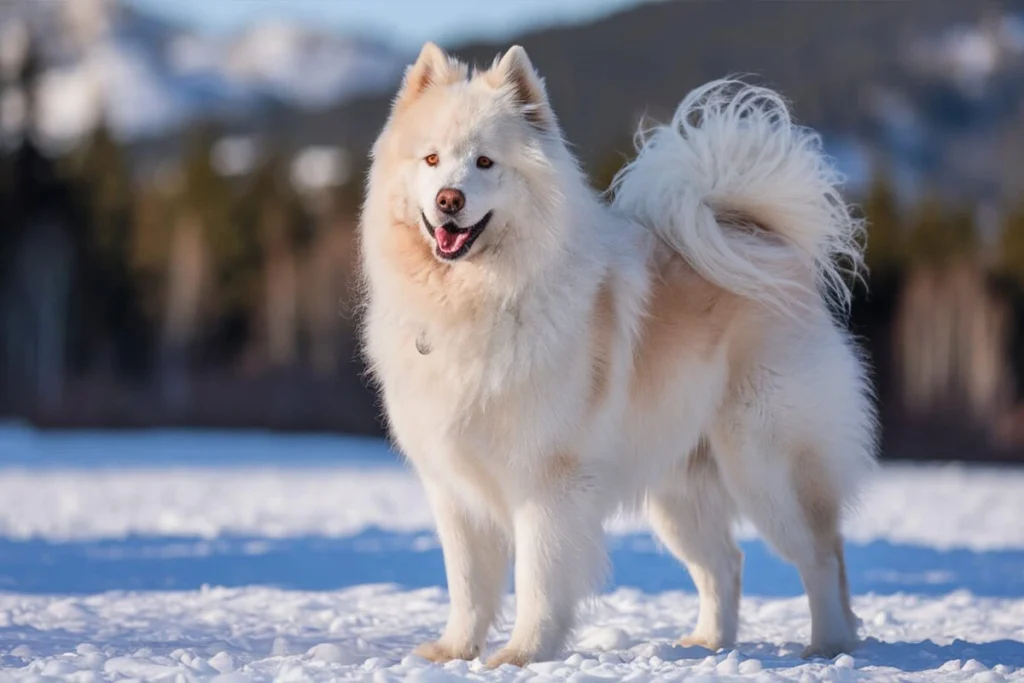
Their gentle and patient temperament makes them one of the best fluffy puppies for families, especially those with children. Samoyeds naturally get along with kids and enjoy playful interactions. They have an affectionate and almost “nanny-like” personality, making them a great addition to homes with young children. Their playful, yet mild-mannered disposition also helps them get along well with other pets, including cats and other dogs.
Because of their high energy levels, Samoyeds do best in active households. They love outdoor adventures, whether it’s hiking, jogging, or simply playing in the yard. Families who enjoy an active lifestyle will find that a Samoyed is a perfect companion for outdoor fun. While they adapt well to different living environments, they thrive best in homes with space to move around, as their energy levels require regular exercise to keep them happy and healthy.
Grooming Needs
A Samoyed’s thick, fluffy coat may be stunning, but it requires dedicated grooming to keep it clean and manageable. Their double coat consists of a dense, woolly undercoat that provides insulation and a longer, coarser outer coat that repels dirt. Because of this, Samoyeds shed heavily, especially during seasonal coat changes in the spring and fall. Daily brushing during shedding seasons helps remove loose fur and prevents excessive buildup around the home.
Outside of shedding seasons, brushing at least three to four times a week keeps their coat soft and tangle-free. Using an undercoat rake or de-shedding tool helps remove dead hair from the undercoat, while a slicker brush smooths out the outer layer. Regular brushing also prevents matting, especially behind the ears, around the neck, and on the legs, where their fur tends to tangle the most.
Samoyeds are naturally clean dogs with fur that repels dirt, but regular baths every six to eight weeks keep their coat bright and fluffy. Bathing too often can strip their fur of natural oils, leading to dryness. After a bath, it’s essential to dry their coat thoroughly, as their thick undercoat can trap moisture, leading to skin irritation or infections.
Trimming their nails, cleaning their ears, and brushing their teeth regularly also contribute to their overall health and well-being. Because Samoyeds are prone to dental issues, incorporating dental chews or routine teeth brushing helps maintain their oral health. Proper grooming not only keeps their coat beautiful but also ensures their skin stays healthy and free from irritation.
Fun Fact
Samoyeds are famous for their signature “Sammy smile”—a natural upturn of their mouth that gives them an always-happy expression. This adorable smile isn’t just for looks; it actually serves a functional purpose. Because Samoyeds originated in Siberia, where temperatures drop to extreme lows, their unique facial structure prevents drool from freezing in cold weather.
These dogs were originally bred by the nomadic Samoyedic people of Siberia to herd reindeer, pull sleds, and provide warmth by sleeping beside their human companions. Their thick coats, strong work ethic, and friendly disposition made them invaluable working dogs in harsh Arctic conditions. Today, while they may not be pulling sleds as often, they still maintain the same affectionate, hardworking, and social nature that made them beloved companions for centuries.
Chow Chow – The Fluffy Lion-Like Companion
Why They’re Great for Families
Chow Chows bring a unique combination of loyalty, independence, and dignity to their families. These fluffy companions form deep bonds with their owners and tend to be very protective of their home. Unlike more playful and overly affectionate breeds, Chow Chows have a more reserved and cat-like personality. They enjoy being around their family but prefer to show love on their terms.
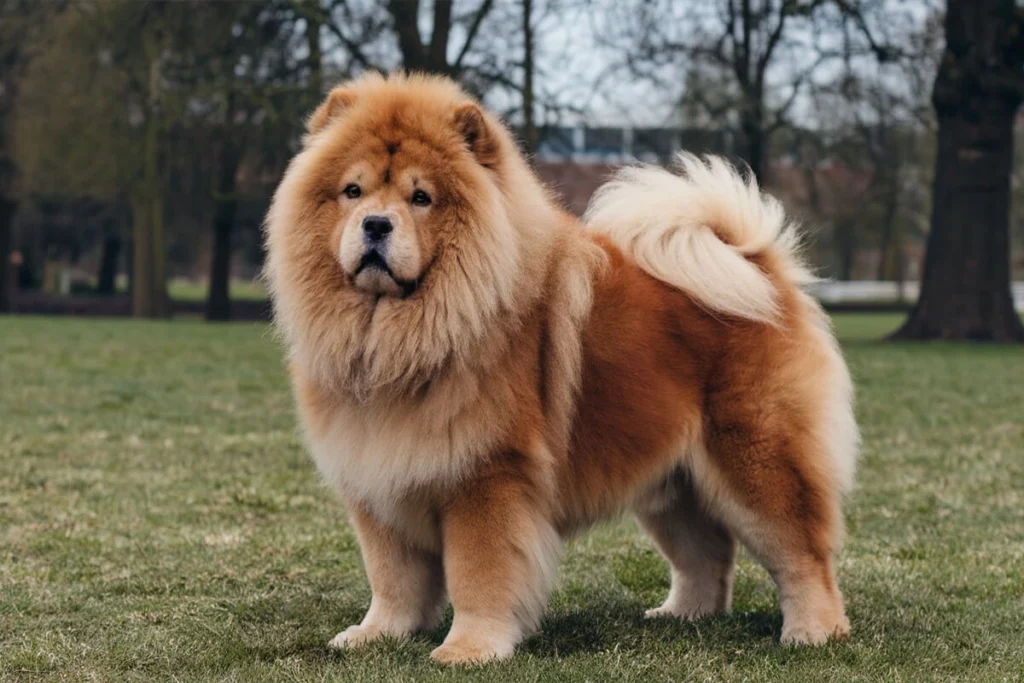
Because of their calm and independent nature, they do well in households that respect their space. They aren’t overly energetic, making them suitable for families who prefer a more low-key companion. However, early socialization is essential to ensure that they get along well with children and strangers. While they may not always seek attention, they are fiercely loyal to their family and will guard them with quiet confidence.
Grooming Needs
Chow Chows have one of the thickest coats among fluffy puppy breeds, which requires frequent brushing to prevent matting and excessive shedding. Their dense fur, which comes in both rough and smooth varieties, needs brushing at least four to five times a week. Using a combination of a slicker brush and an undercoat rake helps remove loose hair and prevent tangles, especially around the neck, chest, and hind legs.
During seasonal coat changes, usually in the spring and fall, their shedding increases significantly. Daily brushing helps manage the extra hair and keeps their coat looking clean. Chow Chows also require routine bathing every 6 to 8 weeks to maintain their thick fur and prevent dirt buildup. Because their coats are so dense, thoroughly drying them after a bath is essential to avoid skin infections.
Their eyes, ears, and wrinkles around their face need regular cleaning to prevent irritation. Since Chow Chows are prone to dental issues, brushing their teeth multiple times a week helps maintain their oral health. Keeping up with their grooming needs ensures that their lion-like mane stays soft, healthy, and free from mats.
Fun Fact
One of the most special things about the Chow Chow dog is its tongue, which is a unique blue-black color. Unlike most dog breeds with pink tongues, Chow Chows are born with pink tongues that darken as they mature. According to Chinese folklore, the blue tongue is a sign of the breed’s mystical origins, with some legends claiming that Chow Chows were once guardians of sacred temples.
Bichon Frise – The Hypoallergenic Cuddle Buddy
Why They’re Great for Families
The Bichon Frise is a cheerful, affectionate, and playful breed that thrives in family environments. These little bundles of joy are known for their happy-go-lucky personalities and love spending time with their human companions. They are incredibly social dogs that get along well with children, adults, and other pets.
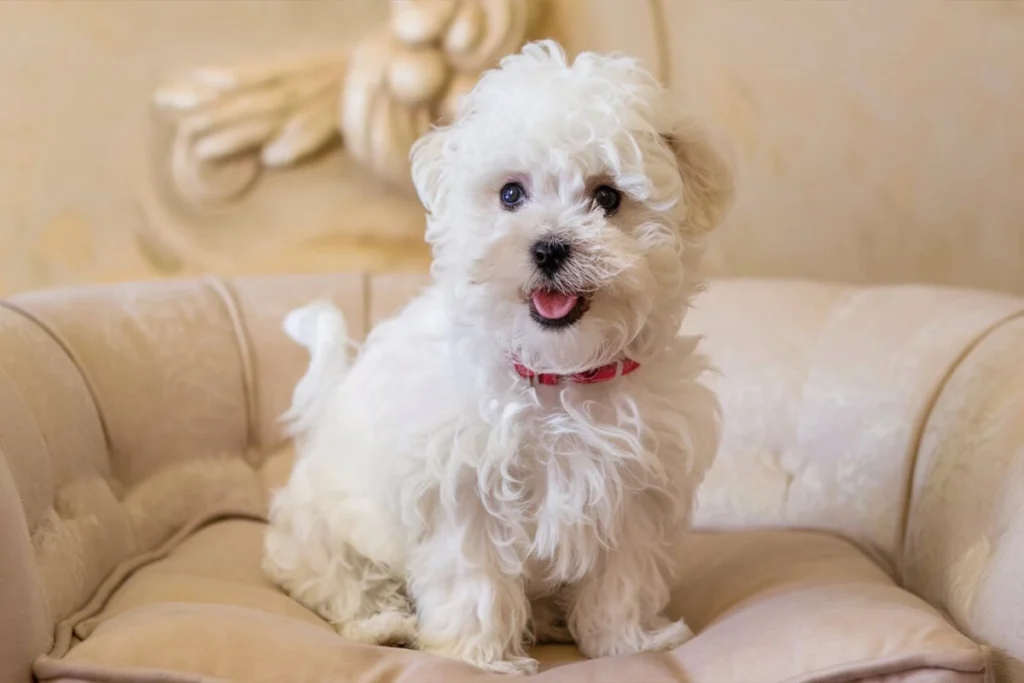
Bichons love to be involved in daily activities, whether it’s playing games, going on walks, or cuddling on the couch. They are highly adaptable and do well in apartments, suburban homes, or larger properties, as long as they receive enough attention and exercise. Unlike some small breeds that can be timid or anxious, Bichons are confident and friendly, making them an excellent choice for first-time dog owners.
Grooming Needs
Bichons have a soft, curly coat that requires frequent grooming to prevent matting and maintain their fluffy appearance. Unlike other small fluffy dog breeds that shed heavily, Bichons are considered hypoallergenic fluffy puppies because they shed very little. However, their curly fur can easily tangle, so daily brushing helps keep their coat smooth and prevents knots.
Since their coat continues to grow like human hair, professional grooming every four to six weeks helps maintain its signature fluffy look. Regular trims around their face, paws, and ears keep them looking neat. Bathing every three weeks ensures their white fur stays clean and bright. In addition to coat care, regular ear cleaning, nail trimming, and teeth brushing help keep them in top shape.
Fun Fact
Bichons were once popular performers in circuses because of their intelligence, trainability, and love for attention. Their playful nature and quick learning abilities made them excellent trick dogs, and they were often seen entertaining audiences with their charming personalities. Even today, Bichons enjoy showing off and love being the center of attention!
Keeshond – The Friendly and Fluffy Companion
Why They’re Great for Families
Keeshonds are affectionate, friendly, and social dogs that thrive on companionship. They create deep connections with their owners and enjoy joining in family activities. Unlike some independent breeds, Keeshonds prefer to stay close to their humans and enjoy constant interaction.
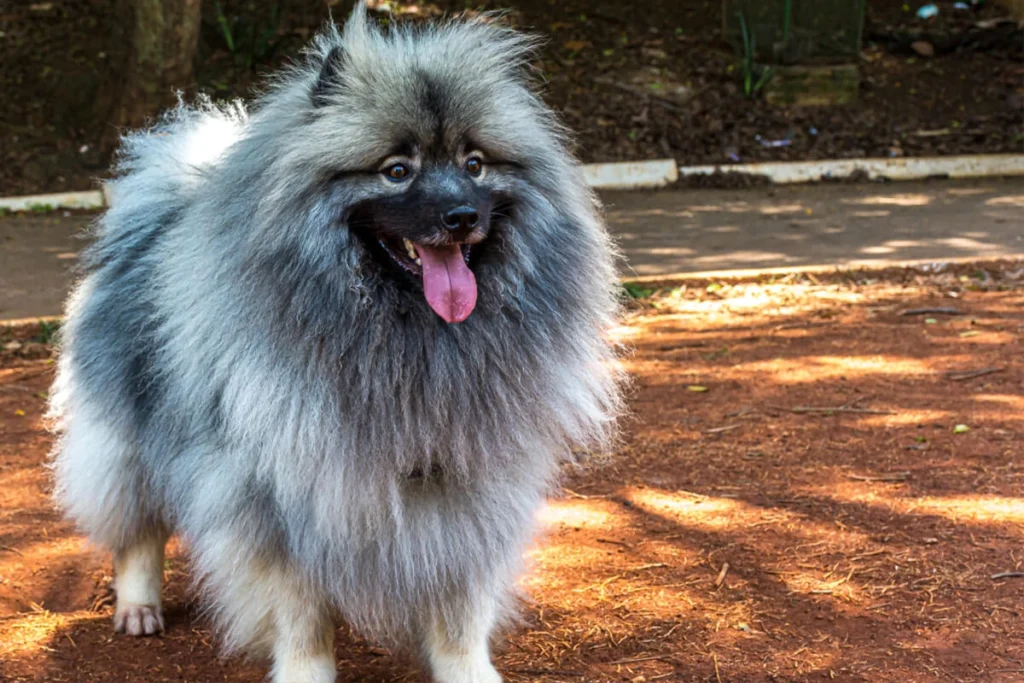
Their gentle and outgoing nature makes them great with children, and they get along well with other pets. They are naturally friendly, making them poor guard dogs, but their alertness ensures they will always notify their family of any unusual activity. Because of their adaptable and affectionate personalities, Keeshonds make wonderful pets for families of all sizes.
Grooming Needs
Keeshonds have a thick double coat that requires consistent care to stay in good condition. Brushing at least three to four times a week helps prevent mats and removes loose fur, especially during seasonal shedding. Their undercoat is dense and woolly, while their outer coat is long and straight, making an undercoat rake an essential grooming tool.
Bathing every six to eight weeks keeps their fur clean, but their coat naturally repels dirt, so frequent bathing isn’t necessary. Like other fluffy puppy breeds, Keeshonds require routine nail trimming, ear cleaning, and dental care to maintain overall health. Regular grooming not only keeps them looking beautiful but also reduces shedding and prevents skin issues.
Fun Fact
Keeshonds were historically known as “Dutch Barge Dogs” because they were commonly found on canal boats in the Netherlands. They served as watchdogs and companions for boat workers, always staying alert while providing affectionate companionship. Their thick coats protected them from harsh weather, making them the perfect fluffy working dogs for life on the water.
Fluffy Puppy Breeds Care: Grooming, Food, and Shedding Management
Grooming Tips for Fluffy Dogs
- Brush your dog’s coat several times a week to prevent tangles and mats.
- Use the right tools, such as an undercoat rake for thick double-coated breeds and a slicker brush for curly coats.
- Bathe your fluffy puppy every 4-8 weeks, depending on their breed and activity level.
- Trim fur around the paws, ears, and eyes to maintain a neat appearance.
- Make sure their ears are clean and do not have any dirt in them. This helps stop infections.
Best Dog Food for Fluffy Breeds
- Choose high-quality dog food rich in omega-3 and omega-6 fatty acids to promote healthy skin and a shiny coat.
- Look for protein-rich foods with real meat as the main ingredient.
- Avoid fillers like corn and soy, which may cause allergies or digestive issues.
- Provide fresh water at all times to keep your dog hydrated and maintain coat health.
Dog Shedding and Maintenance
- Expect seasonal shedding in double-coated breeds like the Samoyed and Chow Chow. Brush daily during shedding seasons.
- Invest in a high-quality vacuum and pet-friendly furniture covers to manage fur around the home.
- Feed your dog a balanced diet to reduce excessive shedding and maintain coat health.
- Regular grooming appointments help keep long-haired breeds manageable and mat-free.
Conclusion
Fluffy puppy breeds bring unmatched warmth, joy, and companionship to any home. Whether you’re drawn to the tiny, energetic Pomeranian, the big, smiling Samoyed, or the regal Chow Chow, each of these fluffy puppy breeds has its own unique charm. These adorable dogs aren’t just fun to cuddle—they also offer unwavering loyalty, affection, and playful energy that make them perfect for families.
However, owning fluffy puppy breeds comes with responsibilities. Their thick coats require regular grooming to prevent matting and excessive shedding. Choosing the right nutrition ensures their fur stays soft, healthy, and vibrant. Understanding their exercise needs and shedding patterns helps create a happy, comfortable environment for both the dog and its family.
Before bringing home a fluffy puppy breed, consider your lifestyle, time for grooming and play, and the specific needs of each breed. While they require commitment, the love and happiness they bring make every effort worthwhile. With proper care, training, and attention, these fluffy puppy breeds will become more than just pets—they’ll be lifelong companions, always ready to offer love and comfort.
If you’re looking for an affectionate, cuddly addition to your family, explore the best fluffy puppy breeds mentioned above and find the perfect match for your home. No matter which breed you choose, the joy of having a soft, fluffy pup snuggled in your arms is an experience like no other!
To Discover more about Dogs and breeds, you can Check This!
Find Some Good Stuff For your Dog On Ped MD Official Website.
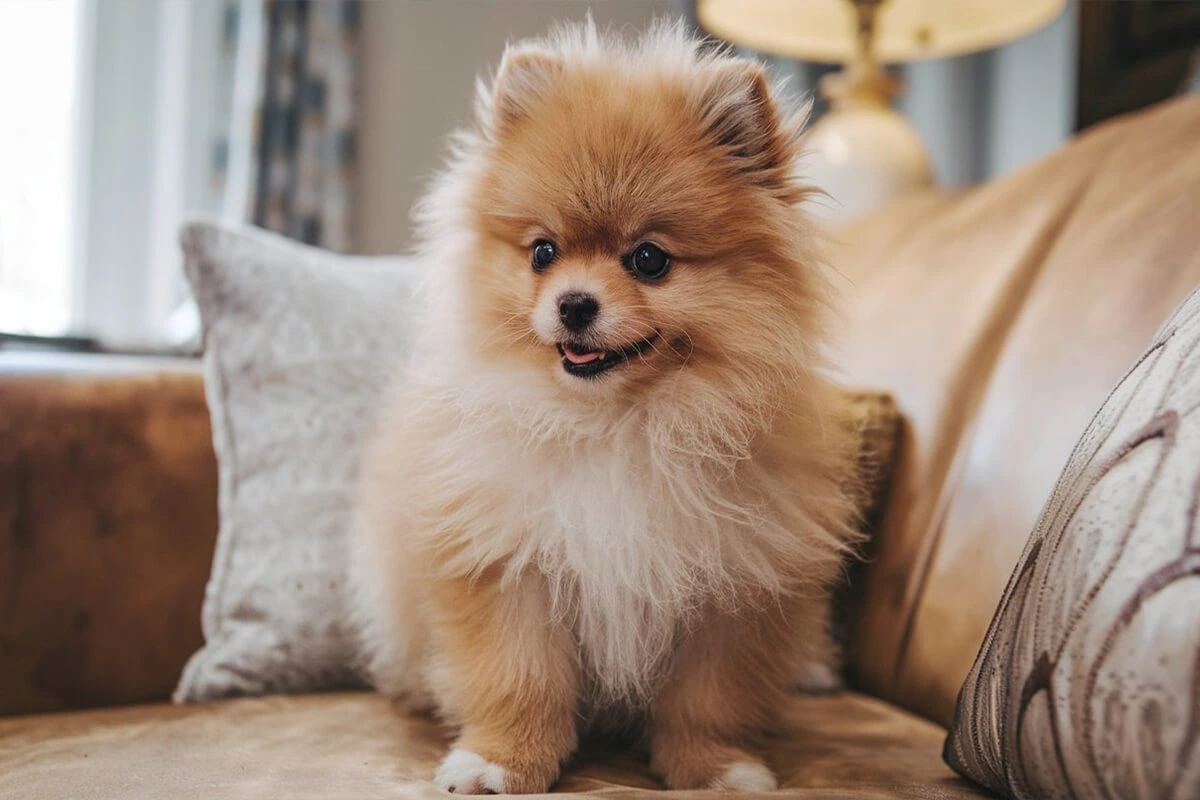
1 thought on “Top 5 Trending Fluffy Puppy Breeds Perfect for Your Family”
Comments are closed.